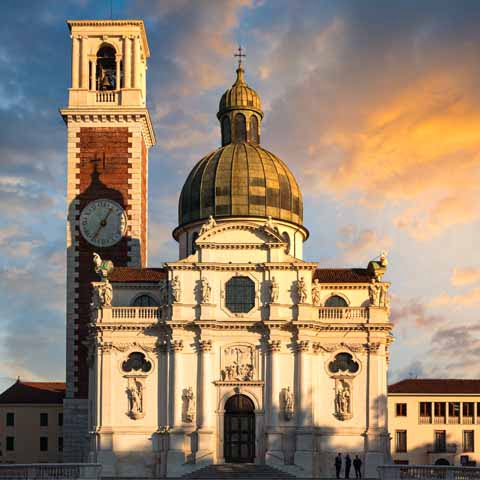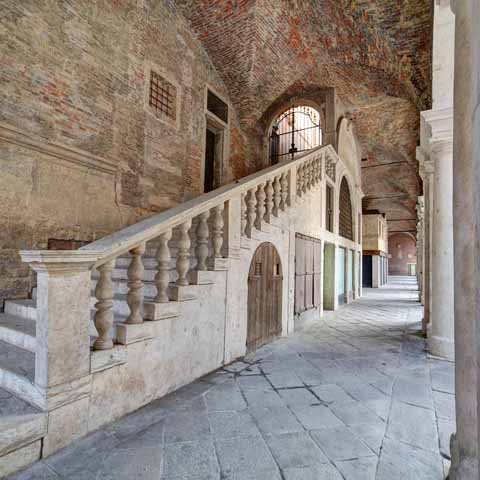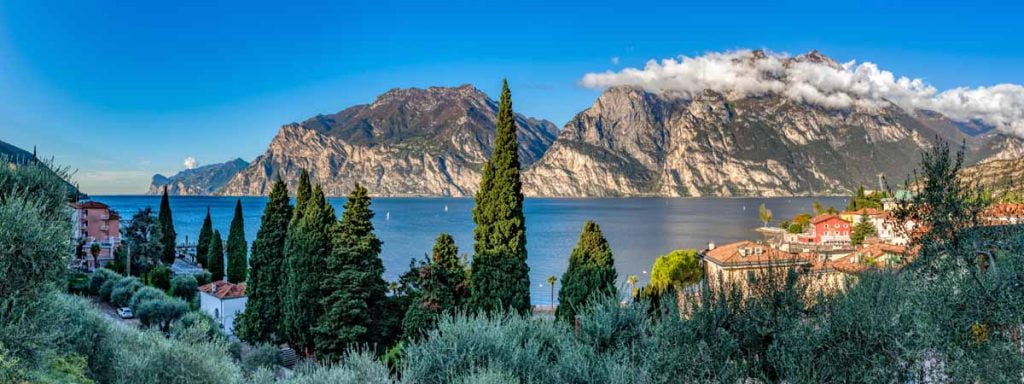Vicenza is a bustling city located in the Northern Italian region of Veneto along the Bacchiglione River. The city is best known for its stunning Renaissance architecture designed by Andrea Palladio. As a designated UNESCO World Heritage Site with the nickname “the City of Palladio”, Vicenza is home to several Palladian palazzi and villas in addition to the famed Teatro Olimpico.
Vicenza is also one of Northern Italy’s principal industrial centers, particularly in the sectors of textile and steel, a fact that has made the city one of the wealthiest in the country. Gold and jewelry-making also contribute greatly to the local economy. Today, the city is a recognized tourism center thanks to its architecture, art, and rich history.
PREHISTORY OF VICENZA
There is no certain historical information on the origins of Vicenza, though it is likely that a first settlement of Veneti was present in the hills of the area during the sixth century BC. There are very few finds from the time that attest to this first settlement.
The inhabitants of ancient Vicetia suffered the influence of the surrounding peoples, Etruscans, Gauls and Cimbri, while maintaining their own cultural identity. The Venetians supported the Romans in the struggles against the Gauls and contributed to the expansion of the Empire in Cisalpine Gaul.
There are still traces of the Roman Empire visible in the remains of the decorated domus, the remains of the supporting arches of the aqueduct that brought water to the city from the surrounding countryside, and the remains of the ancient Roman roads.
Between 49 and 42 BC, Vicenza became a Roman municipium, which means it obtained civil and political rights.
A century later, Vicenza was an important, lively city, which was expanding more and more from a demographic and consequently urbanistic point of view.
HISTORY OF VICENZA
Though the Roman Empire lost its strength in the fifth century, it seems that Vicenza was not the scene of invasions nor destruction. The city maintained a certain importance even with the fall of the Western Roman Empire, thanks to a thriving economy based on the products of the surrounding countryside, the exploitation of the woods, and pastoralism.
It was the Gothic War of 535-553 that weakened and depopulated Vicenza, with periods of famine and epidemics.
Towards the end of the third century, Christianity spread and places of Christian worship, basilicas, and churches were built in the city. In 568, Vicenza was conquered by the Lombards and became a duchy. During the Lombard period, Vicenza became a bishopric seat. It then became a Frank Committee, maintaining a certain political and cultural importance.
The bishop’s power grew and Vicenza became a real episcopal seigniory, not limited to religious power. The Bishop of Vicenza owned lands in addition to holding administrative, juridical, and military power. The power of the Bishop remained significant even in the year 1000 when Vicenza became part of the Marca of Verona and Aquileia, belonging to the Holy Roman Empire.
The Emperors continued to grant privileges to the Bishops of Vicenza who in return guaranteed loyalty. Even during the first period of the struggle for investitures between the papacy and the empire, the bishops of Vicenza stood on the side of the latter.
It was with Emperor Frederick Barbarossa that the cities of the Marca began to not tolerate the increasing pressure from the Emperor and to claim greater autonomy. In 1167, the Marca Veronese joined the larger Lombard League.
After the victory of the Lombard League during the Battle of Legnano, the peace of Constance in 1183 granted the cities greater autonomy. At the end of the twelfth century, Vicenza, like the other Venetian cities, was at the same time an imperial city, an episcopal city, and a municipal city, in which landowners gained more and more power with respect to both the bishop and the Emperor.
During the second half of the twelfth and throughout the thirteenth century, families and rural lords were the true holders of power. It was in this period that noble palaces, fortified houses, castles, and towers flourished. Officially, it was the mayor who ruled the cities, took care of the collection of taxes, and defense in case of danger. The de facto power over the municipality was, however, held by the large families who always controlled, directly or indirectly, the podestà and the consuls.
The struggles between the lordships then flared up and the city weakened until the loss of independence. From 1266, Vicenza passed under the dominion of Padua. The domination lasted for several decades with some episodes of revolt that always failed.
Meanwhile, the power of Verona grew and towards the end of the century Padua, fearing an attack that would find the support of the Vicentines, strengthened the defenses of the city. This was not enough to avoid conquest by the Scaligeri in 1311.
In Vicenza, unlike in other cities, traders and artisans were unable to gain power. Until the nineteenth century, the economy of the city and its territory was always essentially linked to the land.
With the death of Lord of Verona Cansignorio della Scala in 1375, both of his illegitimate sons succeeded him. They reduced taxes and earned the goodwill of the people until one of them had the other murdered and heavy taxes were imposed once more.
In 1385, a coalition was formed in Pavia between the lords of Milan, Mantua, Padua and Ferrara in an anti-Scaligera function, while in 1387, Vicenza passed with Verona under Gian Galeazzo Visconti. With this, the period of the Visconti dominion officially began, and it lasted until 1404.
Under the Visconti, the city’s ruling classes obtained the administration of the territory. The Visconti dominion was rigid, but had a short life; with the death of Gian Galeazzo Visconti in 1402, a regional war broke out again and Vicenza found itself at the center of the dispute, which ended with the absolute victory of Venice over the whole of Veneto.
Vicenza remained under the Republic of Venice until 1797, apart from the period of the League of Cambrai led by Pope Julius II when Vicenza allied itself against the imperials, but was occupied and defeated (1509-1515).
The Vicentine aristocrats tried to match the Venetian nobles in the construction of magnificent residences. The sixteenth century was prosperous for the city, which was embellished with refined villas and palaces. Andrea Palladio was the architect par excellence and even today the buildings and churches of the city are evidence of his great artistic ability. The Palladian Villas were the expression of a dominant, refined class, sensitive to the beauties of nature and art and, at the same time, active in the careful administration of its vast agricultural lands
At the end of the eighteenth century, the ideas of the French Revolution began to spread also among the locals of Vicenza. The ideals of the Revolution were shared by people belonging to different social classes. The Republic of Venice wanted to remain neutral in the conflict between Napoleon and the Habsburg Empire, and agreed to the transit of troops on its territories, including Vicenza.
In 1797, Vicenza was ceded to Austria by Napoleon Bonaparte. Reunited with the Italic Kingdom in 1805, Vicenza returned to Austria from 1814 to 1866, when it became part, with the whole Veneto area, of the Kingdom of Italy.
The Napoleonic Code first and later the Austrian Code had introduced the principle of the equality of all citizens before the law.
The city of Vicenza had therefore become the administrative capital of the territory, without the dominance of the city over the countryside and a greater turnover of the political class.
In 1915, when Italy’s entry into World War I was announced, the city and the province of Vicenza were declared war zones and were immediately involved in the operations. Vicenza made a great contribution.
At the end of the war, Vicenza and its territory faced problems common to all of Italy — the shortage of basic necessities, inflation and the rising cost of living, the need to rebuild, and the impoverishment of most of the population.
World War II also severely damaged the city, which saw many casualties. Theaters, palaces, residences, and churches were destroyed or severely damaged, including the Basilica Palladiana.
At the end of the war, Vicenza received a gold medal for the resistance efforts of its citizens. The reconstruction work led to strong economic development with the spread of small and medium-sized industries.
Today, Vicenza has an industrial network developed in various product sectors, including jeweler, textiles, mechanics, chemicals, pharmaceuticals, leathers, ceramics, and paper. Vicenza is also becoming increasingly renowned worldwide for its vast tourism offerings.
ARCHAEOLOGY OF VICENZA
In Vicenza, near Piazza Duomo, a cryptoporticus was discovered, that is, a structure with a basement gallery. The floor of the cryptoporticus is currently located at a depth of over 20 feet compared to the pavement of the square.
In Sovizzo, located in the province of Vicenza, archaeological excavations have unearthed a megalithic funerary complex dating back to the Copper Age, which has become a permanent open-air museum. Also in Sovizzo, Lombard tombs were discovered at the beginning of the twentieth century.
The Vicenza area, which ranges from mountains to plains, was covered by the sea in the geological past. For 300 million years, the environment was characterized by the presence of emerged lands, coral atolls, and volcanic phenomena. The fossil finds excavated in the Vicenza area are currently preserved in the Natural History and Archaeological Museum of Vicenza, the Civic Museum of Bassano del Grappa, and the Fossil Museum of Villa Godi-Malinverni di Lonedo.
Travel Guides
The Veneto Region of Italy
The Cities of Veneto, Italy












